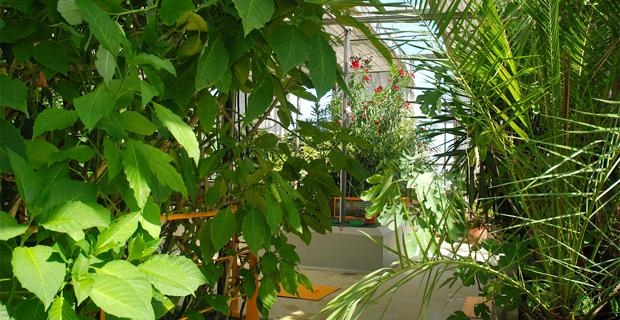
Features
Alternative Fuels
Energy
‘BlueHouse’ technology combines greenhouse with wastewater treatment
October 15, 2012 By Treena Hein
 Organica Waters offers 'BlueHouse' technology - combining greenhouses with wastewater treatment.
Organica Waters offers 'BlueHouse' technology - combining greenhouses with wastewater treatment. Ball State University in Indiana is looking into building a ‘BlueHouse’ – a greenhouse that will treat and recycle its wastewater and save energy.
The University has endorsed the use of ‘BlueHouse’ technology created by Hungary-based Organica Water.
For more of the University’s plans, visit here.
Here are some ‘Frequently Asked Questions’ about their water treatment systems from the Organica Water website:
Isn’t it expensive to heat the greenhouse? Doesn’t it worsen the energy efficiency?
Greenhouses come standard with an energy curtain that reflects heat during the winter nights and provides shading during hot summer days. In addition to solar heat gain, the thermal inertia of the wastewater in the reactors helps to keep the minimal temperature with minimal additional heat.
Do the plants treat the water?
The plants do not treat the water. Their primary function is to provide the habitat in their root zone for the myriads of organisms which thrive there. The microorganisms living in the root zone consume the contaminants in the wastewater.
Is odor control incorporated into the design of the treatment plants?
The odorous processes are entirely enclosed in our designs and can be treated with biofilters. Even the process areas within the treatment plants are entirely odor free.
Are the organisms within the treatment plants imported?
Organica does not import species to inoculate its treatment plants. Every region of the world has local species that can serve the necessary functions for the technology.
What is the benefit of having snails, worms and other higher level organisms in the treatment plant?
The formation of a complex ecosystem with higher life forms enables a broader spectrum of nutrients to be broken down. This effect leads to lower organic matter content in the effluent and to a higher efficiency of ammonia removal. The predatory nature of complex food chains consumes more excess sludge than conventional biological treatment processes, resulting in less waste at the end of the process.
What are the size limitations?
There are no size limitations to our solutions. Larger plants typically use a larger number of treatment trains. We have designed Organica-powered WWTPs for a wide range of sizes and are currently completing an 80,000 m3/d capacity WWTP.
How sensitive is the system to chemicals and heavy metals?
All biological systems, including the ecologies within an Organica-powered WWTP, can be damaged with enough resolve. However, the higher biological diversity of an Organica WWTP displays higher resilience against unexpected loading. Research and experience have shown that Organica treatment plants have a higher resistance to sudden changes in the influent quality and quantity, and thus respond better to shock loading.
What if the plants die?
With correct installation and operation, the plants will thrive in the environment. As in nature, some plants die and new shoots or saplings appear, so removal of dead plant material is part of the operational routine and does not require significant maintenance.
How clean does the water get?
Water is always treated to the required standards set by authorities.
What are the operational costs of an Organica-powered WWTPs?
Due to lower energy consumption, sludge production, and a significantly higher degree of automation Organica-powered WWTPs compare favorably with alternative approaches.
How many people are needed to keep the operation running?
Organica-powered WWTPs are largely automated. For a system up to 25,000 PE (Person Equivalent), one operator is needed for one shift, 5 days a week. International Labor Safety Organization rules, however, require a second operator to be present for safety reasons.
Do the plants make the facility more difficult to operate?
Maintaining a botanical garden is very much like maintaining a home garden. Plant maintenance tasks are detailed in the Operation Manual and only require a few hours of work a week.
Is the solution suitable for retrofitting existing treatment plants?
Organica FCR can easily be adapted for retrofitting. We are increasingly designing solutions for existing plants that would like to increase capacity, improve nutrient removal, or be fully enclosed in one of our greenhouses. This is particularly relevant in growing cities and residential communities experiencing “urban sprawl.”
How long does it take to build an Organica-powered WWTP?
The plants are typically built in six months to one year, depending on the size of the facility and local construction regulations.
Is it difficult to build an Organica-powered WWTP?
Construction of an Organica-powered WWTP is similar to that of conventional solutions and other civil works projects. The vast majority of the equipment is standard in the industry, while a few specialized elements are supplied by Organica.
Are there any special considerations for the construction?
Construction is typically straightforward, so the important considerations are made during the design. We are mindful of tastefully integrating the WWTP into the environment, which is very different from traditional ways of thinking about wastewater facilities.
What is the lifespan of the treatment plant?
The life of the WWTP is a function of maintenance. As in any treatment plant, the pumps, mixers and blowers need to be regularly serviced and replaced every six to seven years. Building components need to be renovated at preset intervals, as is the case with any concrete structure. The biology is self-reproducing, just as in nature, so there is no predetermined lifespan for the actual plants or microorganisms.
Print this page